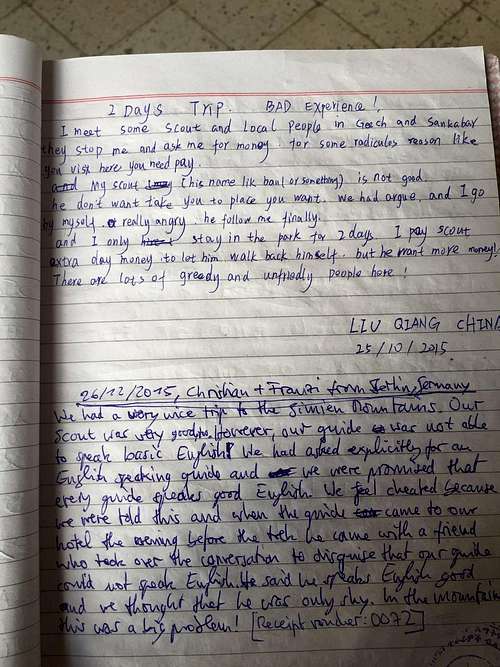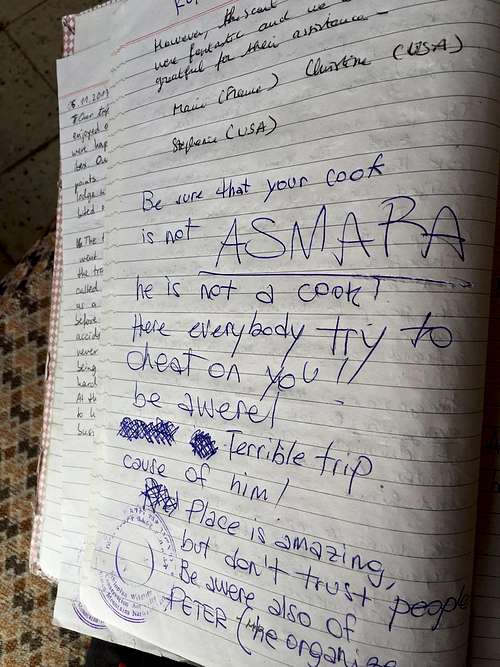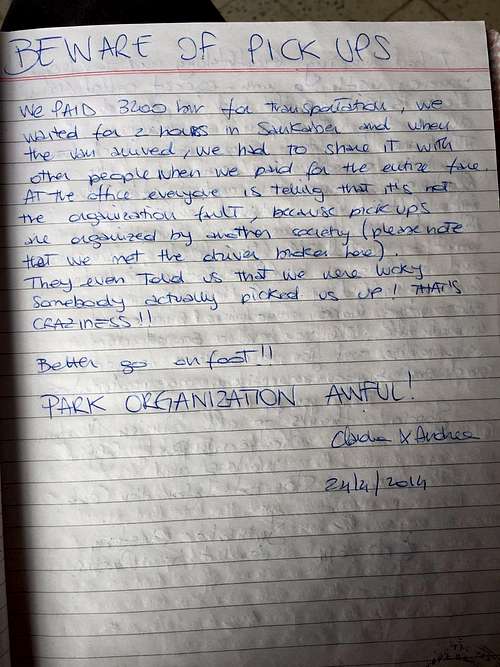|
|
Mountain/Rock |
|---|---|
|
|
13.14500°N / 38.23000°E |
|
|
Beyeda Woreda |
|
|
Hiking |
|
|
Spring, Fall, Winter |
|
|
14872 ft / 4533 m |
|
|
Overview and Warning
Ras Dashen is Ethiopia's highest mountain (4533m). It is also the highest mountain in the Horn of Africa and the tenth highest mountain on the continent. The mountain is also known as Ras Dejen and Ras Dashan. It is located in the Simien Mountains which is an area of rugged mountains, steep ravines and many rare and endemic species. Every visitor will undoubtedly see the amusing Gelada Baboons. I was fortunate enough to also see the endangered Walia Ibex and Ethiopian Wolf, the latter being the rarest wild canine in the world, or so I was told.For all the great things to say about this area, and there is a lot (some of the scenery is out of this world), I would be remiss not to provide a warning:
Policies of Simien Mountains National Park are designed to collect as much revenue from foreign visitors as possible without concern for customer service or environmental preservation.
My opinion was formed after a discussion with the manager of Park HQ at Debark, witnessing the behavior of multiple on-duty scouts and guides, understanding some of the Park's policies and reading the visitor book. Upon completion of my trek while back at Park HQ, I was sharing my experience, both good and bad, with other folks planning to start a trek of their own. I suggested they have a look at the visitor book where I had just finished writing some comments. Upon request, the manager and staff refused to let new visitors read the visitor book prior to their trip. Fortunately, I had already snapped a few pictures (more attached in 'Images' section):
I had similar experiences as others detailed above. See more comments at the bottom of the page that may be helpful for experienced hikers, especially those who would like to be as self-sufficient as possible.
Ethiopia has strained relationships with neighboring Eritrea and nearly all the border areas are not advisable for tourists, so most visitors will arrive at the capital's Addis Ababa Bole International Airport. Many nationalities are offered visas on arrival. Cost was $50 for Americans when I visited in February 2016. The approach from Addis Ababa to the mountain passes Gonder and Debark, the home of Simien National Park Headquarters. Gonder can be reached by either a crowded bus ride that takes most of a day or a short 2 hour flight.
Since my time was limited, I opted to fly. I wanted to fly directly to Gonder but I was told the flights were sold out. The next best thing was to fly to Bahir Dar, which is about 2 hours by car south of Gonder at the south end of Lake Tana. Lake Tana is Ethiopia's largest lake and the source of the Blue Nile. I was hopeful that the drive would be beautiful and perhaps worth the added travel time. Strangely, my flight flew past Bahir Dar and actually landed at Gonder where several foreign tourists disembarked. I followed them off the plane and even got the crew to retrieve my baggage from the cargo hold. However when they realized that my bags were tagged for Bahir Dar they insisted that I get back on the plane for the next leg. I wasn't convinced by their logic, but I ceded. A few hours later I found my way to Bahir Dar's bus terminal and got on a crowded minibus bound for Gonder, the city I had just flown away from mere hours prior. Due to the extra stop, I missed the sunset over Lake Tana and in fact the entire bus ride was in the dark. I arrived in Gonder close to midnight, having started my journey that morning in the suburbs of Shanghai, I was thoroughly exhausted and fell asleep on the first thing I saw that resembled a bed.
(FYI - Ethiopian Airlines has been promoting domestic tourism for at least a few years with a special offer. Anyone who is flying in and out of the country on Ethiopian Airlines can get heavily discounted prices for domestic flights. You must present evidence of your itinerary when purchasing the tickets. How good is the discount? I walked up without reservations and got on the next flight from Bole to Bahir Dar and got another ticket for a return flight from Gonder to Addis six days later. Total fare $131 including tax and fees. I think the full price is about double. Otherwise, I would have had to wait almost 24 hours for the next bus then spend about 30 hours on the road.)
Red Tape and Organized treks
All hikes through the park must be arranged at the park office located in Debark. Even though Ras Dashen lies outside of the park boundaries, the main trail leads through the park. A scout (~3USD/day) is mandatory and a guide is optional (if you want to communicate with your scout). The entrance fees are around 12USD per two days.Located in the Simien Mountains, it is approximately 22km east of the National Park boundaries though most treks start in Debark and cross through the heart of the Park. Once you arrive in Debark, Ethiopia, stop by the park office to organize your trip. Starting from Debark, your journey will look like this:
Debark to Sankaber (22km)
Sankaber to Geech (11km)
Geech to Chennek (11km)
Chennek to Ambiko (14km)
Ambiko to Ras Dashen (8km)
From the summit you can either backtrack or continue on to Dilibza where you can catch a ride. There is one dirt road through the park that goes all the way to 4200m. From there it is a short walk to the summit.
Debark to Sankaber (22km)
Sankaber to Geech (11km)
Geech to Chennek (11km)
Chennek to Ambiko (14km)
Ambiko to Ras Dashen (8km)
From the summit you can either backtrack or continue on to Dilibza where you can catch a ride. There is one dirt road through the park that goes all the way to 4200m. From there it is a short walk to the summit.
Camping and Supplies
Available only at specified campsites: Sankaber, Gich, Chennek, Ambiko.Each campsite is equipped with one or more "traditional style" huts that include a fire ring and seating. There are ground wells at the first three sites. At Ambiko, you must collect water from a not so pure looking stream (a trickle depending on what time of year you come). Be sure to bring warm clothes. It surprises a lot of people that it gets so cold.
The summit climb is nothing more than a long hike following goat trails. There is a small scramble up solid rocks to reach the summit, requiring no technical skill. Views from the summit are less than spectacular. There is a strange phenomenon of feeling lower than almost all of the surrounding mountains. However, the beautiful journey through high altitude villages, and the satisfaction of conquering the mountain, make it an attractive climb.
All supplies that you will need (except warm clothes, boots, etc.) are available for rent in Debark. This includes tents, sleeping bags, blankets, food, stoves, and donkeys. Food is also available from the locals living inside of the park. You can buy eggs, goats, chickens, and even beer!
A few words about the warning
Simien Mountains National Park receives a lot of complaints which are so persistent they deserve to be posted. The Park receives a lot of visitors so I'm not trying to speak for everyone. In fact, I do believe that there are some particular demographics that are served well: older, richer and less-active.
- Scouts beg for money, food and equipment to the point that it becomes uncomfortable. It has become common practice for visitors to tip their guides in these circumstances. Typically that is predicated on the guides providing good service and delivering an unforgettable experience. In Simien Mountains I suspect that the guides pocket very little of the fees that are collected in their name and they depend on the generosity of guests to survive. Regardless, many are convinced that they are rewarded for begging and sometimes will become aggressive if they think it is in their interest. In my case, my guide did not have shoes but only broken plastic slippers and not even a sleeping bag. On a couple occasions he made comments that he wanted me to give him my sleeping bag (I felt so bad for him that I let him borrow my sleeping bag liner for the duration of my trek). He begged for food. The main trail passes through a couple small villages at which point he didn't want to eat the food that he had packed so he begged for money so he could eat at the restaurants along the way. The food is not expensive so I didn't have any problem buying his food at Chennek. At the next village, I offered to buy him a beer which he accepted. He subsequently felt entitled to order two additional bottles for himself which I was obliged to pay for.
- I suggested to Park Management that they should offer training for the guides and scouts. Since the guides and scouts spend the most time with international visitors (whom they agreed generate a lot of revenue for the Park) it seems reasonable that they should have a training system, however, the Park Manager made excuses that "the scouts are poor people and he cannot change their behavior." I left with the feeling that the Park has no sense of responsibility and doesn't care about improving the experience for visitors.
- For a while I entertained the idea that the guns were just for show, to impress western tourists that they were in a wild place; however, one guide who was just beside me fired his rifle while we were on the summit of Ras Dashen.
- gouging for transport
- Aggressive guides pointing guns and threatening their clients
- The pricing is very confusing, 'entrance' fees are not entrance fees
- This a lot of encroachment by villages in a very sensitive environment, the villages do subsistence farming and have a lot of grazing animals that destroy the land








